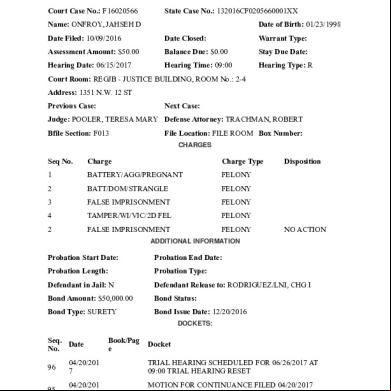Determination Of Specific Rotation Of Lactose 68b30
This document was ed by and they confirmed that they have the permission to share it. If you are author or own the copyright of this book, please report to us by using this report form. Report 3i3n4
Overview 26281t
& View Determination Of Specific Rotation Of Lactose as PDF for free.
More details 6y5l6z
- Words: 1,394
- Pages: 6
Experiment # 7 Optical Rotation: Determination of Specific Rotation of Lactose Sanchez, Charles Francis B., Santiano, John Rey, Tolentino, Celine E., Villanueva, Matthew L. 3-Chem, Department of Chemistry College of Science, University of Santo Tomas
Abstract The experiment was done to determine the specific rotation of lactose. The polarimeter was used to obtain the optical rotations of different concentrations of lactose solutions. These are then used to calculate for the specific rotation of lactose. It was found that as concentration of solution increases, the optical rotation increases. The specific rotation computed was +68.92. Theoretically, the specific rotation of lactose is +52.3. The percent error of the determination is 31.78%.
1.
Introduction Optically active compounds contain chiral centers. Chiral compounds are molecules are
like hands: they are not superimposable on their mirror images [1]. Chiral centers are carbon atoms that have 4 different atoms or groups. It is stated that enantiomers, compounds having chiral centers, will rotate the plane of plane-polarized light in equal amounts but in opposite directions [1]. When an optically active compound was quantified using a polarimeter, observed rotation was obtained. Observed rotation is quantity which is dependent in number of molecules or the concentration, and the path length [1]. By using the standard units of g/mL and dm for standard concentrations and standard pathlength respectively, comparions between compounds can be made. The specific rotation is defined as the observed rotation under standard conditions [1]. The specific rotation can be described mathematically as:
Equation 1: Specific rotation equation Wherein l is the length of the light ing through the sample, c as the concentration and α as the observed rotation. The wavelength, λ, employed is the sodium D line at 589.3 nm.
Polarimeters are used to measure the rotation of plane-polarized light caused by optically active compounds. If the plane-polarized light es through a chiral compound, one of the enantiomers rotates the plane of polarization in a clock-wise manner while the other is counter clockwise [1]. Polarimeters are often used in pharmaceuticals for quality assurance [2]. Lactose is a disaccharide that composes of glucose and galactose [3]. It naturally occurs in milk. In the experiment, the optical rotation of several lactose solutions are to be measured and the specific rotation of lactose are to be determined. 2.
Experimental The experiment required a Zeiss polarimeter. It consists of a control knob, an eyepiece,
and polarimeter tube. When placing a sample in the polarimeter tube, it was made sure that there are no bubbles present in the sample. Bubble containing sample may affect the measurement of optical rotation. Prior to the measurement, the sodium lamp was warmed up for about 10 minutes. The zero point of the polarimeter was obtained by using distilled water as sample and the reading of the blank must be zero. If the reading wasn’t zero, the optical rotation must be recorded and following observations must be ed. Aqueous solutions of assigned sugar was prepared by dissolving 3.0g, 5.0g, 8.0g and 10.00 g to 100mL of distilled water. The following aqueous solutions was filled into the polarimeter tube.The tube was placed in the polarimeter. The control knob was rotated at the right of the instrument for setting the analyzer position, until all the segments in the visual field viewed through the eyepiece are of equal shade. The correct setting was checked by adjusting the control knob. At the proper setting, the dark part in the test field seen through the eyepiece will switch position as the direction of the knob is changed slightly. The analyzer position from the upper scale seen through the eyepiece was read. The optical rotation of different concentrations of aqueous solutions was obtained. The length of the tube was measured and the temperature of the solution was noted. 3.
Results and Discussion Sugars are optically active substances. These substances are the ones that interact with
polarized light to rotate the plane of polarization through some angle [4]. Optically active
substances are either dextrorotatory or levorotatory. Dextrorotatory compounds exhibit positive and clockwise rotation (+), while levorotatory compounds exhibit negative and counterclockwise rotation (-) [1]. Lactose is a dextrorotatory sugar. In the experiment, the optical rotation of different concentrations of lactose was measured. The researchers performed 2 trials. Different trials showed different results making it erroneous. The trials were averaged to get the mean of both results. The obtained results were tabulated below. Table 1. Data of observed rotations Concentration (g/mL)
Trial 1
Trial 2
Mean
0.03
+2.8°
+2.7°
+2.75°
0.05
+3.7°
+2.8°
+3.25°
0.08
+4.3°
+5.3°
+4.8°
0.10
+5.2°
+6.6°
+5.9°
The optical rotation of the trials were plotted against the concentration. The researchers performed two trials. As the graph suggests, there is a directly proportional relationship between concentration and optical rotation. As the concentration of the solution increases, the optical rotation also increases.
Figure 1. Concentration vs. Optical Rotation It is possible to determine the concentration of the sugar solution from its measured optical rotation. To find the concentration is using the equation of the line. The equation of the line was stated in the graph. It can be equated to obtain the concentration of solution by rearranging the equation and solving for x. Another way to determine the concentration is rearranging the formula and the arranged formula of equation 1 was written below.
Equation 2. Arranged specific rotation equation In the new equation, concentration is the observed rotation divided by the length of the tube and the specific rotation. The specific rotation was calculated by using the main formula. The length of the tube was measured as 1dm3. The length is an important variable in solving for the specific rotation. An error in the measured tube will lead to erroneous results. Meanwhile, temperature and wavelength also affects the specific rotation [1]. These factors cannot be incorporated in the formula because the relationship between these factors and specific rotation is not a linear relationship [1]. Doubling the temperature doesn’t translate to doubled observed rotation.
Temperature increase may lead to observed rotation decrease [1]. The factors can be reported in the following format:
Wherein T is reported in Celsius and λ is the wavelength of the light used. The calculated specific rotation was presented in a tabulated form using the mean optical rotation of each concentration. Table 2. Data of mean optical rotation Concentration (g/mL)
Specific rotation
0.03
+ 91.67
0.05
+65.00
0.08
+60.00
0.10
+59.00
The calculated specific rotations deemed to be wrong. The specific rotation of a molecule is a physical constant, like melting point and boiling point [1]. In the concentrations of 0.05, 0.08, and 0.10, the specific rotations are near to each other. Meanwhile, 0.03 is far off with the other data. The specific rotation of lactose is +52.3. The mean specific rotation for the whole experiment is +68.92. The percent error of the measurement was calculated to be 31.78%. Measurement of the data is not desirable due to a large percent error. Errors can be pinpointed to the reading of the image field and incorrect adjustments. If the visual measurement is not consistent or accurate, the data will be wrong. Improper mixing may be a source of error. Suspended particles of undissolved materials might have dispersed the incident polarized light. The readings in various concentrations are not precise. It is recommended to use a modern digital polarimeter if present. No visual observation is required in a digital polarimeter, decreasing the possibility of error.
4.
Conclusion The objective of the experiment was not achieved. It was founded that optical rotation
increase, as the concentration increase. The measured optical rotations are not precise and inaccurate. The calculated specific rotation was +68.92. Compared to the specific rotation of lactose (+52.3), the percent error is 31.78%. The percent relative standard deviation of the specific rotation is 22.33%, a large value is considered imprecision. Large number of percent error is not viable as a successful experiment. Undissolved particles and inaccurate measurement can be the sources of errors. 5.
References
[1] Organic Chemistry, 2nd ed.; Klein, D.; John Wiley & Sons, Inc.: USA, 2014. [2] Polarimetry, http://www.chem.ucla.edu/~bacher/General/30BL/tips/Polarimetry.html (3/4/2017) [3] Fundamentals of Biochemistry, 3rd ed.; Voet, D; Voet, J.G.; Pratt, C.W.; USA, 2008. [4] A Small-scale Approach to Organic Laboratory Techniques, 4th ed.; Pavia, D.L.; Lampman, G.M.; Kriz, G.S.; Engel, R.G.; Cengage Learning: Boston, MA, 2015. Appendix
At 10 grams At 3 grams
At 5 grams
At 8 grams
Abstract The experiment was done to determine the specific rotation of lactose. The polarimeter was used to obtain the optical rotations of different concentrations of lactose solutions. These are then used to calculate for the specific rotation of lactose. It was found that as concentration of solution increases, the optical rotation increases. The specific rotation computed was +68.92. Theoretically, the specific rotation of lactose is +52.3. The percent error of the determination is 31.78%.
1.
Introduction Optically active compounds contain chiral centers. Chiral compounds are molecules are
like hands: they are not superimposable on their mirror images [1]. Chiral centers are carbon atoms that have 4 different atoms or groups. It is stated that enantiomers, compounds having chiral centers, will rotate the plane of plane-polarized light in equal amounts but in opposite directions [1]. When an optically active compound was quantified using a polarimeter, observed rotation was obtained. Observed rotation is quantity which is dependent in number of molecules or the concentration, and the path length [1]. By using the standard units of g/mL and dm for standard concentrations and standard pathlength respectively, comparions between compounds can be made. The specific rotation is defined as the observed rotation under standard conditions [1]. The specific rotation can be described mathematically as:
Equation 1: Specific rotation equation Wherein l is the length of the light ing through the sample, c as the concentration and α as the observed rotation. The wavelength, λ, employed is the sodium D line at 589.3 nm.
Polarimeters are used to measure the rotation of plane-polarized light caused by optically active compounds. If the plane-polarized light es through a chiral compound, one of the enantiomers rotates the plane of polarization in a clock-wise manner while the other is counter clockwise [1]. Polarimeters are often used in pharmaceuticals for quality assurance [2]. Lactose is a disaccharide that composes of glucose and galactose [3]. It naturally occurs in milk. In the experiment, the optical rotation of several lactose solutions are to be measured and the specific rotation of lactose are to be determined. 2.
Experimental The experiment required a Zeiss polarimeter. It consists of a control knob, an eyepiece,
and polarimeter tube. When placing a sample in the polarimeter tube, it was made sure that there are no bubbles present in the sample. Bubble containing sample may affect the measurement of optical rotation. Prior to the measurement, the sodium lamp was warmed up for about 10 minutes. The zero point of the polarimeter was obtained by using distilled water as sample and the reading of the blank must be zero. If the reading wasn’t zero, the optical rotation must be recorded and following observations must be ed. Aqueous solutions of assigned sugar was prepared by dissolving 3.0g, 5.0g, 8.0g and 10.00 g to 100mL of distilled water. The following aqueous solutions was filled into the polarimeter tube.The tube was placed in the polarimeter. The control knob was rotated at the right of the instrument for setting the analyzer position, until all the segments in the visual field viewed through the eyepiece are of equal shade. The correct setting was checked by adjusting the control knob. At the proper setting, the dark part in the test field seen through the eyepiece will switch position as the direction of the knob is changed slightly. The analyzer position from the upper scale seen through the eyepiece was read. The optical rotation of different concentrations of aqueous solutions was obtained. The length of the tube was measured and the temperature of the solution was noted. 3.
Results and Discussion Sugars are optically active substances. These substances are the ones that interact with
polarized light to rotate the plane of polarization through some angle [4]. Optically active
substances are either dextrorotatory or levorotatory. Dextrorotatory compounds exhibit positive and clockwise rotation (+), while levorotatory compounds exhibit negative and counterclockwise rotation (-) [1]. Lactose is a dextrorotatory sugar. In the experiment, the optical rotation of different concentrations of lactose was measured. The researchers performed 2 trials. Different trials showed different results making it erroneous. The trials were averaged to get the mean of both results. The obtained results were tabulated below. Table 1. Data of observed rotations Concentration (g/mL)
Trial 1
Trial 2
Mean
0.03
+2.8°
+2.7°
+2.75°
0.05
+3.7°
+2.8°
+3.25°
0.08
+4.3°
+5.3°
+4.8°
0.10
+5.2°
+6.6°
+5.9°
The optical rotation of the trials were plotted against the concentration. The researchers performed two trials. As the graph suggests, there is a directly proportional relationship between concentration and optical rotation. As the concentration of the solution increases, the optical rotation also increases.
Figure 1. Concentration vs. Optical Rotation It is possible to determine the concentration of the sugar solution from its measured optical rotation. To find the concentration is using the equation of the line. The equation of the line was stated in the graph. It can be equated to obtain the concentration of solution by rearranging the equation and solving for x. Another way to determine the concentration is rearranging the formula and the arranged formula of equation 1 was written below.
Equation 2. Arranged specific rotation equation In the new equation, concentration is the observed rotation divided by the length of the tube and the specific rotation. The specific rotation was calculated by using the main formula. The length of the tube was measured as 1dm3. The length is an important variable in solving for the specific rotation. An error in the measured tube will lead to erroneous results. Meanwhile, temperature and wavelength also affects the specific rotation [1]. These factors cannot be incorporated in the formula because the relationship between these factors and specific rotation is not a linear relationship [1]. Doubling the temperature doesn’t translate to doubled observed rotation.
Temperature increase may lead to observed rotation decrease [1]. The factors can be reported in the following format:
Wherein T is reported in Celsius and λ is the wavelength of the light used. The calculated specific rotation was presented in a tabulated form using the mean optical rotation of each concentration. Table 2. Data of mean optical rotation Concentration (g/mL)
Specific rotation
0.03
+ 91.67
0.05
+65.00
0.08
+60.00
0.10
+59.00
The calculated specific rotations deemed to be wrong. The specific rotation of a molecule is a physical constant, like melting point and boiling point [1]. In the concentrations of 0.05, 0.08, and 0.10, the specific rotations are near to each other. Meanwhile, 0.03 is far off with the other data. The specific rotation of lactose is +52.3. The mean specific rotation for the whole experiment is +68.92. The percent error of the measurement was calculated to be 31.78%. Measurement of the data is not desirable due to a large percent error. Errors can be pinpointed to the reading of the image field and incorrect adjustments. If the visual measurement is not consistent or accurate, the data will be wrong. Improper mixing may be a source of error. Suspended particles of undissolved materials might have dispersed the incident polarized light. The readings in various concentrations are not precise. It is recommended to use a modern digital polarimeter if present. No visual observation is required in a digital polarimeter, decreasing the possibility of error.
4.
Conclusion The objective of the experiment was not achieved. It was founded that optical rotation
increase, as the concentration increase. The measured optical rotations are not precise and inaccurate. The calculated specific rotation was +68.92. Compared to the specific rotation of lactose (+52.3), the percent error is 31.78%. The percent relative standard deviation of the specific rotation is 22.33%, a large value is considered imprecision. Large number of percent error is not viable as a successful experiment. Undissolved particles and inaccurate measurement can be the sources of errors. 5.
References
[1] Organic Chemistry, 2nd ed.; Klein, D.; John Wiley & Sons, Inc.: USA, 2014. [2] Polarimetry, http://www.chem.ucla.edu/~bacher/General/30BL/tips/Polarimetry.html (3/4/2017) [3] Fundamentals of Biochemistry, 3rd ed.; Voet, D; Voet, J.G.; Pratt, C.W.; USA, 2008. [4] A Small-scale Approach to Organic Laboratory Techniques, 4th ed.; Pavia, D.L.; Lampman, G.M.; Kriz, G.S.; Engel, R.G.; Cengage Learning: Boston, MA, 2015. Appendix
At 10 grams At 3 grams
At 5 grams
At 8 grams










